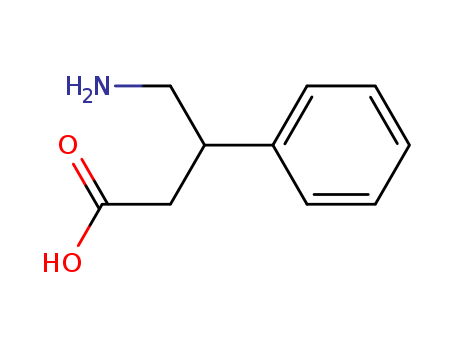
4-Amino-3-phenylbutyric acid hydrochloride
- CasNo:1078-21-3
- Molecular Formula:C10H13NO2
- Purity:
- Molecular Weight:
Product Details
|
1078-21-3 Name |
|
|
Name |
4-Amino-3-phenylbutyric acid hydrochloride |
|
Synonym |
Phenibut;4-AMINO-3-PHENYLBUTANOIC ACID HYDROCHLORIDE;4-AMINO-3-PHENYLBUTIRIC ACID;-Amino-3-phenylbutyric acid hydrochloride;NA###4-Amino-3-phenylbutyric acid hydrochloride;PHENIBUTCAS NO.: 1078-21-3 Phenibut CAS NO.1078-21-3;Nootropics Powder Nutrition Supplement Phenibut for Fatigue Reduce CAS 1078-21-3;TIMTEC-BB SBB001567;PHENIBUT |
|
1078-21-3 Chemical & Physical Properties |
|
|
Melting point |
194.0-202.0°C |
|
Boiling point |
311.75°C (rough estimate) |
|
Density |
1.1248 (rough estimate) |
|
Molecular Formula |
C10H14ClNO2 |
|
Molecular Weight |
215.677 |
|
PSA |
63.32000 |
|
LogP |
2.70590 |
|
Exact Mass |
215.071304 |
|
Index of Refraction |
1.5710 (estimate) |
|
solubility |
Free base: 35 mg/mL in DMSO (195.29 mM) at 25 °C (SellekChem, 2019).Hydrochloride salt (Cayman, 2016): 25 mg/ml in DMF; 20 mg/ml in DMSO; 14 mg/ml in ethanol; 10 mg/mL in PBS (pH 7.2). |
|
1078-21-3 Description |
|
Phenibut, also known as fenibut, phenigamma, and beta-phenyl-gamma-aminobutyric acid, is a derivative of the neurotransmitter GABA. It was developed in Russia,and there it has been used clinically since the 1960s to treat anxiety and related conditions,including insomnia(Lapin,2001). Phenibut has anxiolytic properties and is commonlycompared to benzodiazepines and baclofen.Structurally,phenibut issimilar to GABA, with the addition of the phenyl ring. This allows thecompound to more easily cross the blood-brain barrier, but also changesits activity profile (Shulgina,1986). Scientific studies demonstrate that phenibut can be safely used to treat anxiety, depression,epilepsy, speech disorders, and insomnia. |
|
1078-21-3 Uses |
Phenibut is an anxiolytic and nootropic drug, discovered in the Soviet Union used to treat several psychiatric disorders. It can be used in the treatment of anxiety, depression, asthenia, post-traumatic stress disorder, stuttering, and vestibular disorders. |








